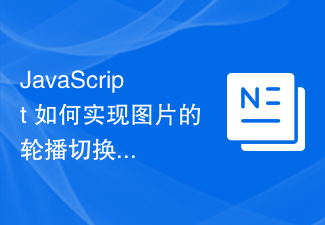 Database
Database Mysql Tutorial
Mysql Tutorial How to use MySQL and JavaScript to implement a simple image carousel function
How to use MySQL and JavaScript to implement a simple image carousel function
How to use MySQL and JavaScript to implement a simple image carousel function
Image carousel is one of the common functions in web development, which can make the website more Attractive and interactive. This article will introduce how to use MySQL and JavaScript to implement a simple image carousel function, and provide specific code examples.
MySQL is a commonly used relational database that can be used to store and manage picture-related information, including the name, path and description of the picture. In this example, we will create a table named images to save image information. The sample code is as follows:
CREATE TABLE images ( id INT AUTO_INCREMENT PRIMARY KEY, name VARCHAR(50) NOT NULL, path VARCHAR(255) NOT NULL, description TEXT );
Next, we will insert some sample data into the images table:
INSERT INTO images (name, path, description)
VALUES ('image1', '/path/to/image1.jpg', '这是第一张图片'),
('image2', '/path/to/image2.jpg', '这是第二张图片'),
('image3', '/path/to/image3.jpg', '这是第三张图片');Now that we have prepared the image data, next we JavaScript will be used to implement the image carousel function. We will use HTML, CSS, and JavaScript to accomplish this.
First, we need to create a container element in HTML to display images and add some navigation buttons for switching images. The sample code is as follows:
<div id="slideshow"> <img id="image" src="" alt="Slideshow Image"> <button id="prev">上一张</button> <button id="next">下一张</button> </div>
Then, we use JavaScript to implement the logic of image carousel. First, we need to get the image data from the server through AJAX and store it in an array. The sample code is as follows:
var images = [];
function getImages() {
var xhr = new XMLHttpRequest();
xhr.open('GET', '/getImages', true);
xhr.onload = function() {
if (xhr.status === 200) {
images = JSON.parse(xhr.responseText);
}
};
xhr.send();
}Next, we need to define a variable currentImage to represent the index of the currently displayed image. We can then initialize the image carousel component after the page loads and add event listeners for the navigation buttons. The sample code is as follows:
var currentImage = 0;
window.onload = function() {
getImages(); // 获取图片数据
var image = document.getElementById('image');
var prevBtn = document.getElementById('prev');
var nextBtn = document.getElementById('next');
// 更新图片显示
function updateImage() {
image.src = images[currentImage].path;
}
// 上一张按钮点击事件
prevBtn.onclick = function() {
currentImage = (currentImage - 1 + images.length) % images.length;
updateImage();
};
// 下一张按钮点击事件
nextBtn.onclick = function() {
currentImage = (currentImage + 1) % images.length;
updateImage();
};
};Finally, we need to use CSS to style the image carousel component so that it presents a good visual effect. The sample code is as follows:
#slideshow {
position: relative;
width: 800px;
height: 400px;
margin: 0 auto;
overflow: hidden;
}
#image {
width: 100%;
height: 100%;
object-fit: cover;
}
#prev,
#next {
position: absolute;
top: 50%;
transform: translateY(-50%);
padding: 10px;
font-size: 16px;
}Now, we have completed using MySQL and JavaScript to implement a simple image carousel function. You can further customize and extend it according to your needs. Hope this article is helpful to you!
The above is the detailed content of How to use MySQL and JavaScript to implement a simple image carousel function. For more information, please follow other related articles on the PHP Chinese website!
 使用CSS实现响应式图片自动轮播效果的教程Nov 21, 2023 am 08:37 AM
使用CSS实现响应式图片自动轮播效果的教程Nov 21, 2023 am 08:37 AM随着移动设备的普及,网页设计需要考虑到不同终端的设备分辨率和屏幕尺寸等因素,以实现良好的用户体验。在实现网站的响应式设计时,常常需要使用到图片轮播效果,以展示多张图片在有限的可视窗口中的内容,同时也能够增强网站的视觉效果。本文将介绍如何使用CSS实现响应式图片自动轮播效果,并提供代码示例和解析。实现思路响应式图片轮播的实现可以通过CSS的flex布局实现。在
 mysql怎么替换换行符Apr 18, 2022 pm 03:14 PM
mysql怎么替换换行符Apr 18, 2022 pm 03:14 PM在mysql中,可以利用char()和REPLACE()函数来替换换行符;REPLACE()函数可以用新字符串替换列中的换行符,而换行符可使用“char(13)”来表示,语法为“replace(字段名,char(13),'新字符串') ”。
 如何使用 PHP 实现图片轮播和幻灯片功能Sep 05, 2023 am 09:57 AM
如何使用 PHP 实现图片轮播和幻灯片功能Sep 05, 2023 am 09:57 AM如何使用PHP实现图片轮播和幻灯片功能在现代网页设计中,图片轮播和幻灯片功能已经变得非常流行。这些功能可以给网页增添一些动态和吸引力,提升用户体验。本文将介绍如何使用PHP实现图片轮播和幻灯片功能,帮助读者掌握这一技术。在HTML中创建基础结构首先,在HTML文件中创建基础结构。假设我们的图片轮播有一个容器以及几个图片元素。HTML代码如下
 JavaScript 如何实现图片的轮播切换效果并加入淡入淡出动画?Oct 18, 2023 pm 12:12 PM
JavaScript 如何实现图片的轮播切换效果并加入淡入淡出动画?Oct 18, 2023 pm 12:12 PMJavaScript如何实现图片的轮播切换效果并加入淡入淡出动画?图片轮播是网页设计中常见的效果之一,通过切换图片来展示不同的内容,给用户带来更好的视觉体验。在这篇文章中,我将介绍如何使用JavaScript来实现图片的轮播切换效果,并加入淡入淡出的动画效果。下面是具体的代码示例。首先,我们需要在HTML页面中创建一个包含轮播图的容器,并在其中添加
 mysql怎么将varchar转换为int类型May 12, 2022 pm 04:51 PM
mysql怎么将varchar转换为int类型May 12, 2022 pm 04:51 PM转换方法:1、利用cast函数,语法“select * from 表名 order by cast(字段名 as SIGNED)”;2、利用“select * from 表名 order by CONVERT(字段名,SIGNED)”语句。
 如何利用PHP开发一个简单的图片轮播功能Sep 25, 2023 am 11:21 AM
如何利用PHP开发一个简单的图片轮播功能Sep 25, 2023 am 11:21 AM如何利用PHP开发一个简单的图片轮播功能图片轮播功能在网页设计中十分常见,能够给用户呈现出更好的视觉效果,提升用户体验。本文将介绍如何使用PHP开发一个简单的图片轮播功能,并给出具体的代码示例。首先,我们需要准备一些图片资源作为轮播的图片。将这些图片放在一个文件夹内,并命名为"slider",确保文件夹路径正确。接下来,我们需要编写一个PHP脚本来获取这些图
 如何通过WordPress插件实现图片轮播功能Sep 06, 2023 pm 12:36 PM
如何通过WordPress插件实现图片轮播功能Sep 06, 2023 pm 12:36 PM如何通过WordPress插件实现图片轮播功能在如今的网站设计中,图片轮播功能已经成为一个常见的需求。它可以让网站更具吸引力,并且能够展示多张图片,达到更好的宣传效果。在WordPress中,我们可以通过安装插件来实现图片轮播功能,本文将介绍一种常见的插件,并提供代码示例供参考。一、插件介绍在WordPress插件库中,有许多图片轮播插件可供选择,其中一款常
 如何使用HTML、CSS和jQuery制作一个动态的图片轮播Oct 25, 2023 am 10:09 AM
如何使用HTML、CSS和jQuery制作一个动态的图片轮播Oct 25, 2023 am 10:09 AM如何使用HTML、CSS和jQuery制作一个动态的图片轮播在网站设计和开发中,图片轮播是一个经常使用的功能,用于展示多张图片或广告横幅。通过HTML、CSS和jQuery的结合,我们可以实现一个动态的图片轮播效果,为网站增加活力和吸引力。本文将介绍如何使用HTML、CSS和jQuery制作一个简单的动态图片轮播,并提供具体的代码示例。第一步:设置HTML结


Hot AI Tools

Undresser.AI Undress
AI-powered app for creating realistic nude photos

AI Clothes Remover
Online AI tool for removing clothes from photos.

Undress AI Tool
Undress images for free

Clothoff.io
AI clothes remover

AI Hentai Generator
Generate AI Hentai for free.

Hot Article

Hot Tools

Safe Exam Browser
Safe Exam Browser is a secure browser environment for taking online exams securely. This software turns any computer into a secure workstation. It controls access to any utility and prevents students from using unauthorized resources.

Notepad++7.3.1
Easy-to-use and free code editor

MantisBT
Mantis is an easy-to-deploy web-based defect tracking tool designed to aid in product defect tracking. It requires PHP, MySQL and a web server. Check out our demo and hosting services.

Dreamweaver CS6
Visual web development tools

ZendStudio 13.5.1 Mac
Powerful PHP integrated development environment





